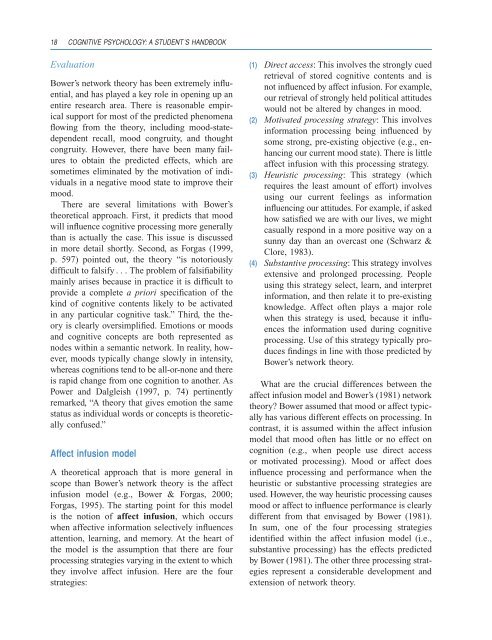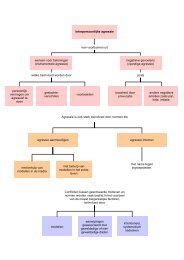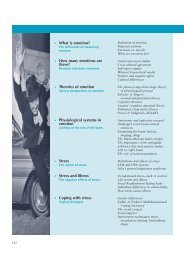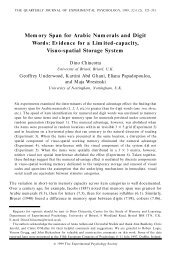Chapter 18: Cognition and Emotion - Psychology Press
Chapter 18: Cognition and Emotion - Psychology Press
Chapter 18: Cognition and Emotion - Psychology Press
Create successful ePaper yourself
Turn your PDF publications into a flip-book with our unique Google optimized e-Paper software.
<strong>18</strong> COGNITIVE PSYCHOLOGY: A STUDENT’S HANDBOOK<br />
Evaluation<br />
Bower’s network theory has been extremely influential,<br />
<strong>and</strong> has played a key role in opening up an<br />
entire research area. There is reasonable empirical<br />
support for most of the predicted phenomena<br />
flowing from the theory, including mood-statedependent<br />
recall, mood congruity, <strong>and</strong> thought<br />
congruity. However, there have been many failures<br />
to obtain the predicted effects, which are<br />
sometimes eliminated by the motivation of individuals<br />
in a negative mood state to improve their<br />
mood.<br />
There are several limitations with Bower’s<br />
theoretical approach. First, it predicts that mood<br />
will influence cognitive processing more generally<br />
than is actually the case. This issue is discussed<br />
in more detail shortly. Second, as Forgas (1999,<br />
p. 597) pointed out, the theory “is notoriously<br />
difficult to falsify . . . The problem of falsifiability<br />
mainly arises because in practice it is difficult to<br />
provide a complete a priori specification of the<br />
kind of cognitive contents likely to be activated<br />
in any particular cognitive task.” Third, the theory<br />
is clearly oversimplified. <strong>Emotion</strong>s or moods<br />
<strong>and</strong> cognitive concepts are both represented as<br />
nodes within a semantic network. In reality, however,<br />
moods typically change slowly in intensity,<br />
whereas cognitions tend to be all-or-none <strong>and</strong> there<br />
is rapid change from one cognition to another. As<br />
Power <strong>and</strong> Dalgleish (1997, p. 74) pertinently<br />
remarked, “A theory that gives emotion the same<br />
status as individual words or concepts is theoretically<br />
confused.”<br />
Affect infusion model<br />
A theoretical approach that is more general in<br />
scope than Bower’s network theory is the affect<br />
infusion model (e.g., Bower & Forgas, 2000;<br />
Forgas, 1995). The starting point for this model<br />
is the notion of affect infusion, which occurs<br />
when affective information selectively influences<br />
attention, learning, <strong>and</strong> memory. At the heart of<br />
the model is the assumption that there are four<br />
processing strategies varying in the extent to which<br />
they involve affect infusion. Here are the four<br />
strategies:<br />
(1) Direct access: This involves the strongly cued<br />
retrieval of stored cognitive contents <strong>and</strong> is<br />
not influenced by affect infusion. For example,<br />
our retrieval of strongly held political attitudes<br />
would not be altered by changes in mood.<br />
(2) Motivated processing strategy: This involves<br />
information processing being influenced by<br />
some strong, pre-existing objective (e.g., enhancing<br />
our current mood state). There is little<br />
affect infusion with this processing strategy.<br />
(3) Heuristic processing: This strategy (which<br />
requires the least amount of effort) involves<br />
using our current feelings as information<br />
influencing our attitudes. For example, if asked<br />
how satisfied we are with our lives, we might<br />
casually respond in a more positive way on a<br />
sunny day than an overcast one (Schwarz &<br />
Clore, 1983).<br />
(4) Substantive processing: This strategy involves<br />
extensive <strong>and</strong> prolonged processing. People<br />
using this strategy select, learn, <strong>and</strong> interpret<br />
information, <strong>and</strong> then relate it to pre-existing<br />
knowledge. Affect often plays a major role<br />
when this strategy is used, because it influences<br />
the information used during cognitive<br />
processing. Use of this strategy typically produces<br />
findings in line with those predicted by<br />
Bower’s network theory.<br />
What are the crucial differences between the<br />
affect infusion model <strong>and</strong> Bower’s (1981) network<br />
theory? Bower assumed that mood or affect typically<br />
has various different effects on processing. In<br />
contrast, it is assumed within the affect infusion<br />
model that mood often has little or no effect on<br />
cognition (e.g., when people use direct access<br />
or motivated processing). Mood or affect does<br />
influence processing <strong>and</strong> performance when the<br />
heuristic or substantive processing strategies are<br />
used. However, the way heuristic processing causes<br />
mood or affect to influence performance is clearly<br />
different from that envisaged by Bower (1981).<br />
In sum, one of the four processing strategies<br />
identified within the affect infusion model (i.e.,<br />
substantive processing) has the effects predicted<br />
by Bower (1981). The other three processing strategies<br />
represent a considerable development <strong>and</strong><br />
extension of network theory.





